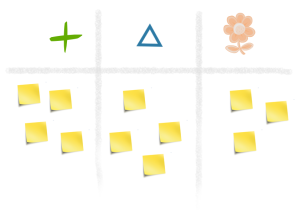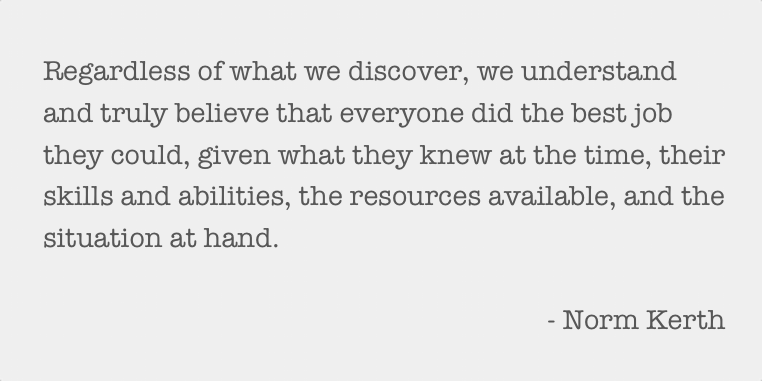
One of the pillars of today’s businesses is change. Small startups struggle to find a stable customer niche; large companies want to deliver things faster. The business environment is also changing, and we are trying hard to keep moving forward. But because of the hectic pace of the business world, very often we fail to look back and review our actions. In today’s article, I would like to describe the concept of retrospectives – a tool which allows people to move forward by looking back.
What are retrospectives?
Retrospective comes from the Latin word retrospectare, which means: to look back. Today the term has its roots in the field of software development: the Scrum framework and Agile Manifesto. The last of the Manifesto’s twelve principles says that:
At regular intervals, the team reflects on how to become more effective, then tunes and adjusts its behavior accordingly.

In the broadest sense, a retrospective is a meeting which occurs on a regular basis during the development process, and during which the entire team attends and discusses how the most recent iteration (or some stage of the project) went.
During the retrospective, the team can learn what was good about the process, and which areas need to be improved. Finally, the team decides what actions it should take to improve their work. The entire process of inspection and adaptation calls to mind the concept of a self-repairing mechanism.
Why bother doing retrospectives?
A quite common question which arises among agile newbies is: is it worth spending additional time discussing something that is already history and cannot be changed? The answer is quite simple: definitely. Looking back and reviewing the process allows people to move forward more confidently about the future.
A famous definition of insanity says that it is: “doing the same things and expecting different results”. This may seem obvious, but still many people fail to understand this and continue to repeat the same mistakes over and over again. This fallacy has implications for projects, businesses and our own personal lives.
If we want to be safer or to perform better we need a quick feedback loop. A feedback loop allows us to review our current behavior and modify it, if necessary. If we humans were not able to learn that fire is dangerous at the very second that we touch it, there would a lot fewer people living on the Earth. In his book “Thinking, Fast and Slow“, Daniel Kahneman writes:
True intuitive expertise is learned from prolonged experience with good feedback on mistakes.

Doing a retrospective helps people to notice relevant issues quicker, and gives them the ability to make changes accordingly. Interestingly, retrospectives are not only limited to fixing mistakes; retrospectives also help the teams to be more engaged in their work, give them the feeling of being an important part of the decision-making process, develop empathy and openness among them and strengthen the positive acknowledgement of events.
Retrospectives can be also used in a wider context. They can be used in businesses to regularly improve the strategy of the company and review recent undertakings. With my wife, we use retrospectives at home to improve our marriage and keep it healthy. Honest retrospectives can be even used in the personal self-development process.
How to perform a good retrospective
The idea of retrospectives could not be simpler: discuss what went really well, what areas need to be improved on, and then choose some action points to ensure that the future would be better. But doing a good retrospective can be challenging.
There are many books that are available which contain compiled examples of various exercises that help in doing retrospectives. The example below is based mainly on my own work experience in cases where I have been a participant and a moderator in dozens of retrospectives.
Generally, even though each retrospective is (and should be!) different, the majority contain a few pre-defined stages:
- The Introduction.
- Gathering the data.
- Understanding the data.
- Defining action points and closing.
The introduction
The introduction stages of retrospectives are sometimes skipped, because people tend to jump right into solutions, thinking that talking about stuff and not doing stuff seems like a waste of time. But eventually, a well-conducted introduction can shape the entire retrospective and make the final outcome more complete.
One way to begin the meeting is to create and tell ourselves a story about how the previous week went by. This step involves the people in the discussion and helps them to recall what actually happened. Hearing the story from different perspectives also creates common ground for the shared understanding of problems.
An introduction is also helpful for changing the mindset of the participants. Norm Kerth developed something called The Retrospective Prime Directive:
Having this in mind, we can pursue positive improvements instead of falling into a blame game where everyone is blaming each other for particular problems. The next step is gathering the data.
Gathering and understanding the data
In my current job we create sticky notes, where we put our various thoughts, which fit into 3 different categories:
- What went well? (Pluses +)
- What do we need to improve? (Deltas Δ)
- Who would we like to praise? (Flowers ⚘)
 We place our sticky notes on the whiteboard and talk about them among ourselves. This helps all of us to understand the data better. After everyone takes their turn, we prioritize the deltas using a method similar to the Eisenhower Matrix.
We place our sticky notes on the whiteboard and talk about them among ourselves. This helps all of us to understand the data better. After everyone takes their turn, we prioritize the deltas using a method similar to the Eisenhower Matrix.
Defining action points and closing
First of all, we pick the things that need a relatively small amount of work, but at the same time can bring substantial improvement. Then, we pick things that are very important to us, but to fix them we need to develop some types of long-term improvement processes. At the same time, we are constantly trying to get a better understanding of the problems at hand. For any given issue we perform the root-cause analysis, and we are trying to spot some common points that exist among them.
At the very end of the retrospective, we try to develop a plan for improvements. It is very important to keep this order and talk about solutions last. Very often solutions which attempt to rectify unsolvable or unimportant problems can be problems in themselves. Additionally, each improvement needs to have its owner – someone who will be responsible for making sure that the given solution will be actually introduced.
Then, during the week we try to introduce the improvement and take appropriate actions. In the next retrospective we always begin with reviewing what we have accomplished with the improvements we introduced previously, and then the whole process repeats.
Summary
In CayenneApps we believe that to move forward, we need to stand still for a moment and plan our actions consciously by identifying top priorities and defining goals. Retrospectives complement this process by cultivating the habit of looking back before planning any new actions. This is a great (yet simple!) tool which can bring great improvement to your businesses or even your personal lives. It is definitely worth trying because ultimately hindsight is better than foresight.
If you are interested in the topic of more effective and productive meetings (not only retrospectives!), please stay tuned! In the next post we will write a lot more about this subject. Also, please visit our website, where you will be able to discover what your top business priorities are and define your long-term objectives.





Great post. I actually attended a regular monthly roundtable that focuses on agile topics this week. The topic was retrospects and many of the same points came from that discussion that you shared in your write-up.
Thanks for your comment! I believe that having a good retrospective is the key to making a good agile teams great!
Interesting article, thanks!
I think that one of the key things to make retrospectives valuable is to use suitable exercises. By valuable I mean exercises that help teams to better understand what has happened and to take action. Suitable will often depend on the team and situation at hand.
The retrospective facilitator (often the scrum master) should have a toolbox of retrospective techniques, and be able to pick the most effective one. Some of the techniques to do retrospectives are asking questions, state your feelings with 1 word, 5 times why (Root Causes) or asking why, solution focused/strengths and retrospective of retrospectives.
@BenLinders
Co-author Getting Value out of Agile Retrospectives
Thanks for your comment, Ben!
I think that having a toolbox of retrospective techniques is particularly important in mature teams. Having the same type of retrospective over and over again can be a performance and motivation killer.
If you are interested in different exercises there’s a exercises toolbox on my weblog. See http://www.benlinders.com/exercises/
I published it a couple of days ago, there will be more exercises added in the coming weeks.
Do you think this is useful?